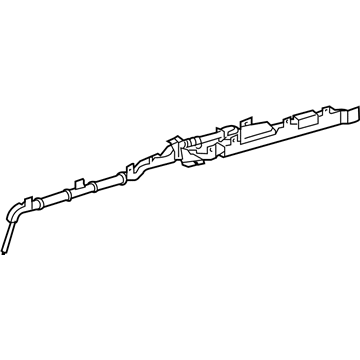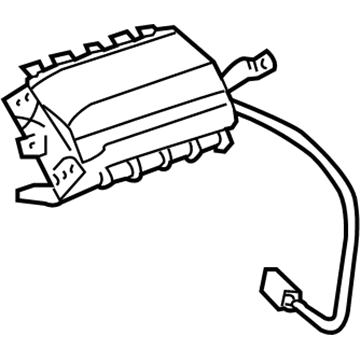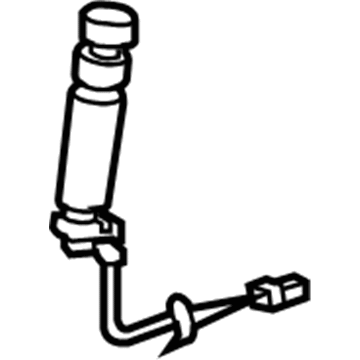×
ToyotaParts- Hello
- Login or Register
- Quick Links
- Live Chat
- Track Order
- Parts Availability
- RMA
- Help Center
- Contact Us
- Shop for
- Toyota Parts
- Scion Parts
My Garage
My Account
Cart
OEM 2009 Toyota FJ Cruiser Air Bag
Air Bag Module- Select Vehicle by Model
- Select Vehicle by VIN
Select Vehicle by Model
orMake
Model
Year
Select Vehicle by VIN
For the most accurate results, select vehicle by your VIN (Vehicle Identification Number).
5 Air Bags found
2009 Toyota FJ Cruiser Inflator Curtain, Driver Side
Part Number: 62180-35033$1111.61 MSRP: $1629.08You Save: $517.47 (32%)Ships in 1-3 Business DaysProduct Specifications- Other Name: Air Bag Assembly, Curtain Shield; Curtain Air Bag, Left; Head Air Bag; Air Bag Assembly, Curtain Shield, Driver Side
- Position: Driver Side
- Replaces: 62180-35030, 62180-35032
- Part Name Code: 62180A
- Item Weight: 11.70 Pounds
- Item Dimensions: 47.8 x 18.7 x 9.5 inches
- Condition: New
- Fitment Type: Direct Replacement
- SKU: 62180-35033
- Warranty: This genuine part is guaranteed by Toyota's factory warranty.
2009 Toyota FJ Cruiser Inflator Curtain, Passenger Side
Part Number: 62170-35033$1173.47 MSRP: $1719.73You Save: $546.26 (32%)Ships in 1-3 Business DaysProduct Specifications- Other Name: Air Bag Assembly, Curtain Shield; Curtain Air Bag, Right; Head Air Bag; Air Bag Assembly, Curtain Shield, Passenger Side
- Position: Passenger Side
- Replaces: 62170-35030
- Part Name Code: 62170A
- Item Weight: 11.40 Pounds
- Item Dimensions: 48.3 x 18.6 x 9.3 inches
- Condition: New
- Fitment Type: Direct Replacement
- SKU: 62170-35033
- Warranty: This genuine part is guaranteed by Toyota's factory warranty.
2009 Toyota FJ Cruiser Passenger Air Bag
Part Number: 73960-35070$583.95 MSRP: $855.78You Save: $271.83 (32%)Ships in 1-3 Business DaysProduct Specifications- Other Name: Air Bag Assembly, Instrument Panel; Instrument Panel Air Bag, Upper; Passenger Inflator Module; Air Bag Assembly, Instrument Panel Passenger W/O Door
- Part Name Code: 73960A
- Item Weight: 8.00 Pounds
- Item Dimensions: 15.3 x 11.4 x 7.7 inches
- Condition: New
- Fitment Type: Direct Replacement
- SKU: 73960-35070
- Warranty: This genuine part is guaranteed by Toyota's factory warranty.
2009 Toyota FJ Cruiser Side Impact Inflator Module, Passenger Side
Part Number: 73910-52070$350.92 MSRP: $514.28You Save: $163.36 (32%)Ships in 1-3 Business DaysProduct Specifications- Other Name: Air Bag Assembly, Front Seat; Seat Air Bag, Front Right; Front Seat Air Bag; Air Bag Assembly, Front Seat, Passenger Side
- Position: Passenger Side
- Part Name Code: 73910A
- Item Weight: 2.60 Pounds
- Condition: New
- Fitment Type: Direct Replacement
- SKU: 73910-52070
- Warranty: This genuine part is guaranteed by Toyota's factory warranty.
2009 Toyota FJ Cruiser Side Impact Inflator Module, Driver Side
Part Number: 73920-52070$388.39 MSRP: $569.18You Save: $180.79 (32%)Product Specifications- Other Name: Air Bag Assembly, Front Seat; Seat Air Bag, Front Left; Front Seat Air Bag; Air Bag Assembly, Front Seat, Driver Side
- Position: Driver Side
- Part Name Code: 73920A
- Item Weight: 2.80 Pounds
- Condition: New
- Fitment Type: Direct Replacement
- SKU: 73920-52070
- Warranty: This genuine part is guaranteed by Toyota's factory warranty.
2009 Toyota FJ Cruiser Air Bag
Looking for affordable OEM 2009 Toyota FJ Cruiser Air Bag? Explore our comprehensive catalogue of genuine 2009 Toyota FJ Cruiser Air Bag. All our parts are covered by the manufacturer's warranty. Plus, our straightforward return policy and speedy delivery service ensure an unparalleled shopping experience. We look forward to your visit!
2009 Toyota FJ Cruiser Air Bag Parts Q&A
- Q: What precautions should be taken when servicing the air bag system equipped with a Supplemental Restraint System (SRS) on 2009 Toyota FJ Cruiser?A: The Supplemental Restraint System in the vehicle incorporates driver Air Bag and front passenger Air Bag along with side Air Bags and curtain shield Air Bags and front seat belt pretensioners therefore demanding detailed service operations for SRS safety. Waiting at least 90 seconds should be done after turning off the ignition and removing the negative (-) terminal cable from the battery because the SRS maintains its own power supply. The SRS components including steering pad as well as Air Bag assemblies and sensors must never be exposed to heat or flames. High impedance voltage and ohm meters (with minimum 10 kOhms/V) should be used during troubleshooting alongside DTC checks before battery disconnection because many symptoms cannot be easily verified. Examine every affected component when a vehicle sustains a minor collision because this should include the steering pad and the different Air Bag assemblies. It is essential to detach the Air Bag sensor before starting any operation that could generate shock to it while using only new parts because old parts from other vehicles must never be used for replacement purposes. Replace and adjust Air Bag sensors only after permitting at least 90 seconds to pass after disconnecting the negative cable terminal. Expertly follow the mechanisms used for SRS connectors because yellow-colored components require specific locking procedures to block incorrect connections. SRS work must end with a warning light check followed by system reset procedures for components affected by the disconnect of the negative (-) terminal cable while maintaining clear documentation about previously stored system contents.















